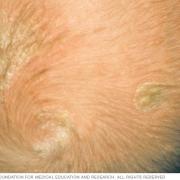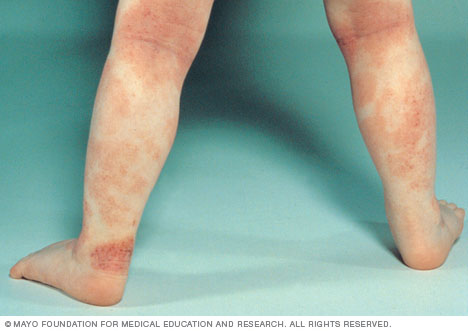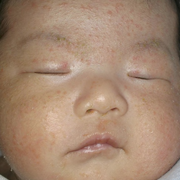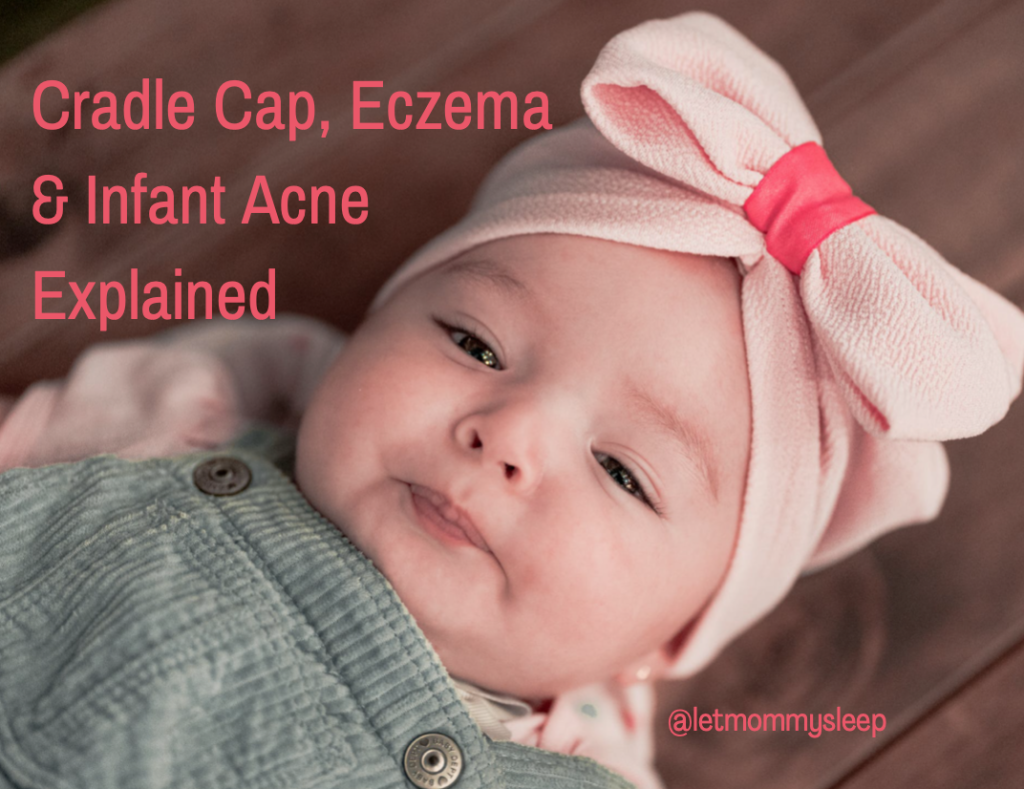Cradle Cap, Eczema, and Infant Acne Explained
updated July 22, 2025 – After spending 9 months in the womb, it makes sense that newborns might experience skin conditions in their new environment! This blog Cradle Cap, Eczema, and Infant Acne Explained shares common reasons newborns experience skin irritation and how you can help.
Key Takeaways
- Cradle cap usually affects the scalp and can be gently managed with gentle baby shampoo and brushing.
- Eczema presents as red, itchy patches and may be triggered by dryness, allergens, or even saliva. Managing it often means moisturizing, avoiding triggers, and using prescription creams if needed.
- Infant acne is harmless, related to maternal hormones, and doesn’t require treatment beyond gentle cleansing.
- Other harmless baby skin conditions include milia, heat rash, dry skin, and diaper rash. These usually resolve with good hygiene and minor adjustments.
- Call your pediatrician if your newborn has hives with swelling or breathing issues, sores, white patches in the mouth or red spots in the diaper area or has a fever/is acting unwell along with these skin conditions.
- Skin conditions in babies are not a sign of poor care! They’re usually the result of an immature immune system and delicate skin adjusting to life outside the womb.

Cradle Cap, Eczema, and Infant Acne Explained
What is Cradle Cap?
Cradle cap is scales and redness on a baby’s scalp. When this rash occurs on the scalp alone, it’s known as cradle cap. It may start as scaling and redness of the scalp and can also extend to the face and diaper area, too. When it does, pediatricians call it seborrheic dermatitis (because it occurs where there are the greatest number of oil producing sebaceous glands).

Seborrheic dermatitis is a noninfectious skin condition that’s very common in infants, usually beginning in the first weeks of life and slowly disappearing over a period of weeks or months. It is rarely uncomfortable or itchy.
Treatment:
Cradle cap is not harmful and will typically go away on its own by baby’s first birthday. It can be treated, by washing hair frequently with a mild baby shampoo and using a soft brush to remove the scales. Some doctors recommend a stronger, medicated shampoo or cortisone cream. These may remove the scales quickly but can be irritating to baby’s sensitive skin. Only use them after consulting a pediatrician.
It is not recommended to use baby oil or mineral oil on cradle cap. Doing so allows the scales to build up on the scalp, particularly over the fontanelle, or soft spot on baby’s head. Sometimes a yeast infection may form on the crease areas of the skin (rarely on the scalp.) If this happens, the area will be red and itchy. Seek the care of a pediatrician who may prescribe an anti-yeast cream.
What is infant eczema?
Infant eczema known as atopic dermatitis (AD), is a chronic skin problem that causes red, dry, and itchy rashes. In babies, the rashes usually occur on the face or scalp or folds of skin. According to the American Academy of Pediatrics, it is the most common skin problem treated by pediatric dermatologists. Eczema can be hereditary and occur in conjunction with allergies or asthma. Also baby’s saliva from drooling can provoke irritation. Eczema in babies tends to be worse in the drier, winter months.

Eczema. See more examples of eczema via the Mayo Clinic
Treatment:
Infant eczema usually clears up before 4 years of age. Before then however, different triggers cause eczema so treatment can vary.
Parents should contact their pediatrician for specific direction but common non-medical treatments include:
- eliminating certain foods from baby’s diet – we should note that eliminating certain foods to see if baby’s eczema clears up is appropriate for children on solid food, there is conflicting advice on elimination diets for exclusively breastfed babies.
- The AAP suggests that “lactating mothers with infants at high risk of developing AD should avoid peanuts and tree nuts, and should consider eliminating eggs, cow’s milk, and fish from their diets.”
- However, La Leche League states that mother’s almost never need to limit their diets. So, parents can try an elimination diet while breastfeeding or use the other tips below.
- using mild soaps, moisturizers and detergents specially made for sensitive baby skin
- dressing baby in lightweight, loose fabrics or try skin -soothing fabrics
- putting a cool-mist humidifier in baby’s bedroom
- In some cases, a prescription cream or oral medicine may be prescribed.
It’s important to note that eczema doesn’t usually require urgent care, but tending to it early with over-the-counter treatments like moisturizers or mild hydrocortisone (with your doctor’s okay) can keep it from escalating. Call the doctor if your newborn’s eczema is getting worse or spreading despite gentle care at home or if your baby seems very itchy or uncomfortable.
What is infant acne?
Infant acne is harmless acne that is often caused by exposure to maternal hormones in utero. Many babies develop infant acne around a few weeks of age, and in most cases, the acne is gone before baby reaches six months. While we think of acne appearing most often on the face, it can also occur on baby’s chest or back.

Treatment:
Unlike acne in adolescents and adults, infant acne requires no special treatment or medication. Clean the area daily with warm water, mild soap, and pat gently dry. Since baby acne is not caused by dirt, do not over wash the area. This can cause irritation and parents should mention the acne to their pediatrician to rule out other skin conditions.
Other Harmless Skin Conditions: Milia, Heat Rash and Diaper Rash
In addition to cradle cap, eczema, and infant acne, there are several other common and generally harmless skin conditions that can appear in newborns and infants. Common conditions include:
- Milia – tiny white bumps that often show up on the nose, chin, or cheeks. These occur when dead skin gets trapped in small pockets near the skin’s surface and usually clear on their own within a few weeks.
- Heat rash, also known as prickly heat – presents as small pink or red bumps in areas where sweat gets trapped, like skin folds, especially in warm weather or when a baby is overdressed. It’s not serious but is a sign that baby is too hot and should be made cooler.
- Diaper rash – is another nearly universal issue and has its own category for treatment. It happens because of prolonged exposure to moisture, friction, or in some cases, yeast or bacterial overgrowth. This makes sense since your baby is wearing a diaper and while most cases improve with barrier creams and frequent diaper changes, persistent or severe rashes should be seen by a pediatrician.
- Dry and peeling skin in the first few days or weeks of life, especially if your baby was born past their due date. This is totally normal and often resolves without treatment.
When to Call the Doctor
Before we talk specifics, just a reminder that it’s never wrong to contact your pediatrician if you need explanation or just feel something isn’t right. That said, there are a few skin conditions that may require medical attention:
Hives (aka “urticaria”) appear as sudden raised welts that are often itchy and can come and go. Hives are usually caused by allergies, illness and occasionally for no clear reason. If hives appear with swelling, trouble breathing, or feeding issues, immediate care is needed.
Impetigo is a bacterial skin infection that shows up as red sores or blisters that develop a honey-colored crust. It’s contagious and typically needs antibiotic treatment. Impetigo can happen if baby is exposed to someone who has strep throat or a staph infection.
Yeast infection, (aka “Thrush“) can present in 2 ways:
- White patches on the tongue, cheeks, or roof of the mouth that don’t wipe away easily. This can be uncomfortable for your newborn, so they might act fussy while feeding.
- Bright red patches with well-defined edges and small red spots close by in the diaper area.
Yeast infections thrive in a moist environment so they’re not uncommonly in babies. It can also happen after use of antibiotics.
Viral Infection – Viral infections are not common but are serious. Rashes caused by viral infections can begin as blisters or sores and are considered a medical emergency, especially if the baby also has a fever or seems unwell. Once again, trust your instincts if a rash is spreading quickly, accompanied by other symptoms, or just doesn’t seem right.

Why do Infant Skin Conditions Happen?
The thing to remember about these three skin conditions is that they…just happen because baby’s skin is still maturing. Parents aren’t doing anything wrong when these conditions present, and there is usually no reason for nursing mothers to change their own diets.
Skin issues are usually simply due to baby’s little body adjusting to the world outside the womb. The skin barrier is still developing and is thinner than adult skin. Additionally a newborn’s skin doesn’t hold moisture as well and is more prone to dryness and irritation, and sweat and oil gland function is still developing.
If you’d like more tips about early newborn care, read Your First Week Home with Baby: Ultimate Q&A.
Categories
- Corporate Care & Partners
- COVID19 Archive
- En Espanol
- Expert Guides
- Hiring a Night Nanny
- Infant Safety
- Infant Sleep Hub
- Newborn Care
- Postpartum Health
- Twins & Multiples
- Work as a Night Doula
- zPost Archives
